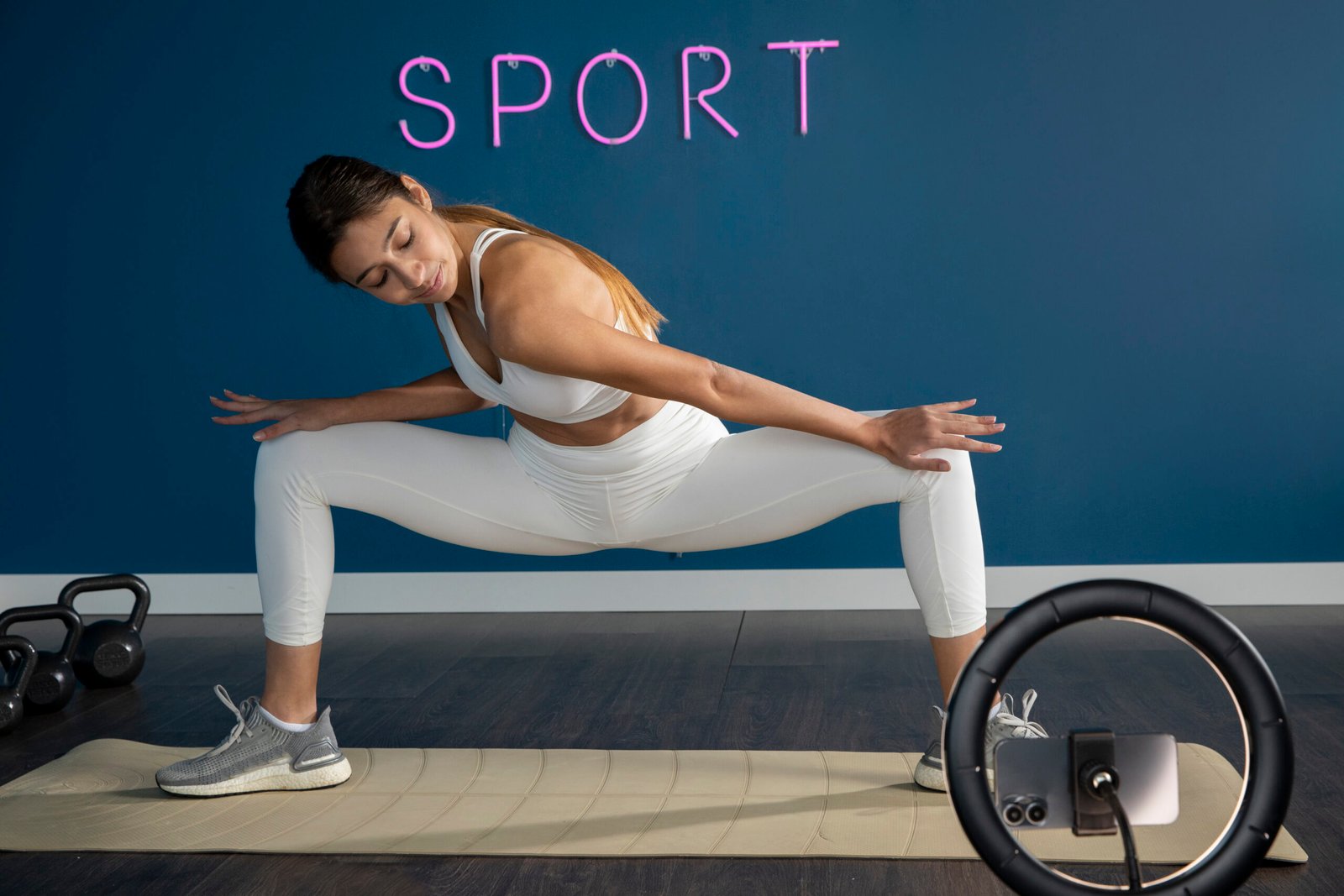.jpg)
Seven Powerful Exercises to Control PCOS
An endocrine condition known as polycystic ovarian syndrome, or PCOS, impacts millions of women globally. A comprehensive strategy is needed to manage PCOS, and frequent exercise is essential to symptom relief. Here, we go over seven powerful exercises that might help you control PCOS and enhance your general health.
1. HIIT, or high-intensity interval training
For women with PCOS, High-Intensity Interval Training (HIIT) is a very beneficial exercise regimen. With HIIT, brief intervals of high-intensity exercise are interspersed with rest or low-intensity workouts. This kind of exercise can support:
Enhancing insulin sensitivity:
It has been demonstrated that HIIT can improve insulin sensitivity, which is frequently compromised in PCOS-affected women.
Fat burning: HIIT is a great way to burn fat, particularly visceral fat, because it is typical in PCOS.Increasing metabolism: Because HIIT workouts are so hard, they can increase your metabolism for hours after the workout.
Example of HIIT Workout
Warm-up: five minutes of brisk walking or gentle running.
First interval: thirty seconds of running, then ninety seconds of walking.
Make eight to ten rounds of Interval 1.
Cool down with a five-minute stretch and leisurely stroll.
2. Exercise for Strength
Another essential element of an exercise program that is PCOS-friendly is strength training. Strength training for the purpose of muscle building can:
Boost metabolism:
When at rest, muscle tissue burns more calories than fat.
Enhance body composition: A higher percentage of muscle can aid in a lower total fat percentage.
Hormone regulation: Strength training can assist in hormone balance, which will lessen PCOS symptoms.
Strength Training Program
Perform a 5-to 10-minute gentle cardio warm-up.
Exercise 1: Three sets of twelve reps of squats.
Exercise 2: 3 sets of 10 repetitions of deadlifts.
Exercise 3: Three sets of bench press three sets of ten repetitions.Exercise 4: Three sets of twelve reps of bent-over rows.
Use foam rolling and stretches to wind down.
3. Asana
Yoga is a fantastic, low-impact workout that is especially beneficial for PCOS-affected ladies. Regular yoga practice can assist with:
Stress reduction: Yoga helps people relax and cope with stress, which can make PCOS symptoms worse.
.jpg)
Increasing flexibility:
Yoga increases range of motion and lowers the chance of injury.
Hormone balance: A few yoga poses have the ability to activate endocrine glands and assist with hormone regulation.
PCOS Yoga Pose
Assume Butterfly Pose (Baddha Konasana) by sitting with your knees apart and your feet together. With your feet still in place, slowly raise and lower your knees.
Bridge Pose (Setu Bandhasana): Place your feet flat on the floor and bend your knees while lying on your back. Raise your hips in relation to the ceiling.
Lie on your stomach with your hands beneath your shoulders to perform the Cobra Pose (Bhujangasana). Take your torso off the ground.
elbows in close proximity to your body.
4. Exercises for the Heart
Exercises that involve the heart, such swimming, cycling, and running, are essential for PCOS management. These activities support:
Enhancing heart health:
Cardiovascular health, which is frequently weakened by PCOS, is improved by regular exercise.
Calorie burning: Cardio exercises are a good way to help burn calories and lose weight.
Mood enhancement: The release of endorphins during cardio exercise has been shown to alleviate anxiety and enhance mood.
Cardio Exercise ProgramWarm-up:
five to ten minutes of brisk walking or jogging.The main exercise consists of moderate-intensity cardio (running, cycling, or swimming) for 30 to 45 minutes.
Cool down with brisk walking or light stretching for five to ten minutes.
5. Yoga
Pilates is a low-impact workout that emphasizes bettering general body alignment and core strength. Pilates can help PCOS-affected women:
Strengthen your core: Good posture and a reduced back pain can be achieved with a strong core.
Increased flexibility can be attained with Pilates movements, which lengthen and stretch muscles.
Reduce stress: Pilates encourages calm, deliberate movement, which helps to reduce stress.
Pilates Program
The One Hundred: Place your legs in a tabletop posture and lie on your back. As you breathe in and out for a count of 100, vigorously pump your arms up and down.
Laying on your back, roll up witharms outstretched above. After rolling slowly up to a sitting posture, extend your arm to touch your toes.
Leg Circles: While lying flat on your back, stretch one leg upward. Move your leg in little clockwise and counterclockwise circles.

6. Diving
Swimming is a full-body exercise that is easy on the joints, so it’s perfect for PCOS women. Swimming has several advantages, such as:
Low impact:
Swimming minimizes joint stress and lowers the chance of damage.
Workout for the entire body: Swimming works several muscle groups at once.
Stress relief: Swimming’s rhythmic motion may be incredibly relaxing and pleasant.
Exercise Swimming
Swim gently for five to ten minutes as a warm-up.
Main set: swim laps for 20–30 minutes at different intensities.
Cool down by floating or swimming gently for five to ten minutes.
7. Dancing Exercises
Dancing exercises are an enjoyable and practical approach to manage PCOS and keep active. Dancing is beneficial for:
Calorie burning:
Dancing exercises are a fun approach to burn calories.
Enhancing balance and coordination: Dancing enhances balance and coordination.
Improving mood: Dancing’s upbeat vibes can ease tension and improve mood.
Dance Exercise Program
Warm-up: Five minutes of gentle stretching or dancing.
Dance for 30 to 45 minutes, concentrating on various types (salsa, hip-hop, and zumba) is the main workout.
Cool down with a few minutes of stretching or slow dancing.
In conclusion, including these exercises in your program can aid in the proper management of PCOS symptoms. Finding workouts you enjoy and can stick with over time is crucial, as is consistency.
8. Strolling
One of the easiest and most convenient ways to exercise is to walk. Walking has many advantages for women with PCOS without requiring specialized equipment or a gym membership. Frequent strolling can:
Boost cardiovascular health:
Walking on a daily basis helps to increase circulation and heart power.
Assist with weight management: Walking on a regular basis can help you burn calories and control your weight.
Boost mood: Walking can lower stress and promote mental health, especially when done in a natural setting.
Walking ScheduleWalk slowly for five minutes to gradually raise your heart rate as a warm-up.Main walk: brisk walking for 30 to 60 minutes. Strive to stroll at a speed that allows you to converse but not sing.
Stretching after five minutes of leisurely walking is the cool-down.
9. Classes for Aerobic Dancing
Dance motions and conventional aerobic workouts are combined in aerobic dance classes like Zumba and Jazzercise. These courses offer an enjoyable and practical approach to address PCOS symptoms while keeping active. Advantages consist of:
Burn a lot of calories quickly: Aerobic dancing burns a lot of calories quickly.
Social engagement: Attending classes in groups can boost morale and offer support from others.
Enhanced coordination: The variety of motions aids in enhancing agility and coordination.
Structure of Aerobic Dance Classes
5–10 minutes of gentle dancing as a warm-upand extending.
Main class: energizing dance patterns with varied intensities for 30 to 45 minutes.
Stretching and a kinder dance for five to ten minutes is the cool-down.
10. Cycling Cycling is a fantastic cardiovascular workout that can assist in PCOS management. Regardless of your preference for indoor or outdoor riding, there are a number of advantages to this sport:
Joint-friendly:
Compared to jogging, cycling has less impact on the joints due to its low impact.
Enhanced cardiovascular endurance is a result of regular riding.
Cycling works the main muscle groups in the body, such as the legs, glutes, and core.
Plan for Cycling Exercise
Warm-up:
five to ten minutes of gentle cycling.
Cycling for 30 to 60 minutes at a moderate to high level is the main workout. For an extra challenge, incorporate higher-intensity intervals.
Stretching comes after 5–10 minutes of gentle cycling to cool off.
11. Exercises Using Your Bodyweight
Without requiring any equipment, bodyweight workouts are a quick and efficient technique to increase strength and control PCOS symptoms. You may perform these exercises anywhere and they use your own body weight as resistance. Advantages consist of:
Better tone:
Bodyweight workouts aid in the development and toning of muscles.
Flexibility gains: A lot of bodyweight workouts also enhance mobility and flexibility.
Convenience: You can do these workouts anyplace you have room, whether it’s at home or in a park.
Routine for Bodyweight Exercise
Warm-up: 5–10 minutes of active stretching or mild aerobic exercise.
Exercise 1: Three sets of ten to fifteen push-ups.
Exercise 2: Three sets of twelve reps per leg of lunges.
Exercise 3: Three sets of 30–60 seconds of planks.
Exercise 4: Three sets of fifteen reps of glute bridges.
.jpg)
Use foam rolling and stretches to wind down.
12. Barre Exercises
Pilates, yoga, and ballet are all incorporated into barre workouts to produce a special kind of exercise that helps people with PCOS. Small, deliberate movements that increase strength, flexibility, and balance are the main focus of these exercises. Advantages consist of:
Increased core strength:
Barre exercises work the core, which contributes to increased stability and strength.
Better posture can be achieved by putting more attention on alignment and form.
Low impact:
Barre exercises are good for all fitness levels because they are easy on the joints.
Routine for Barre Exercises Warm-up: Light cardio and stretching for five to ten minutes.Exercise1: Three sets of fifteen reps of plies.
Exercise 2: Leg Lifts (15 repetitions per leg, 3 sets).
Exercise 3: Three sets of fifteen repetitions of arm circles.
Exercise 4: Core Work: Perform three sets of 15 repetitions of different core exercises.
Stretch gently, concentrating on the back, hips, and legs as you cool down.
In summary
Including a range of exercises in your program can greatly aid in the management of PCOS symptoms. It’s critical to identify interests and activities you can stick with. For optimal effects, always remember to combine exercise with a healthy diet and other lifestyle practices. Before beginning any new fitness regimen, always get medical advice, especially if you have any underlying medical issues.










Leave a Reply